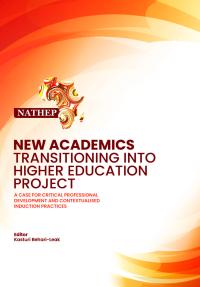New Academics Transitioning into Higher Education: a case for critical professional development and contextualised induction practices
Synopsis
The New Academics Transitioning into Higher Education Project, known as NATHEP, is part of a national collaborative project in Higher Education (HE), focused on the professional development of academic staff developers who are involved in the induction programmes of new academics transitioning into HE. Using a cascading model of staff development, NATHEP explored structural and cultural opportunities and constraints that inhibited or promoted the emergence of critical induction programmes to respond to new academics’ needs and to the needs of students. Given the complexity and contested nature of the current higher education landscape (UCDP, 2018), new academics face numerous challenges as they embed themselves in disciplinary and institutional contexts. With systemic conditions not being conducive to critical agency and social justice, current induction practices for new academics are inadequate to the task of transformation in higher education (Behari-Leak, 2015), making new academics especially vulnerable (Behari-Leak, 2017).
NATHEP focused on developing a national orientation to induction practices and principles across the sector. Twenty academic staff developers from 10 universities were supported to initiate and convene well-theorised and conceptualised induction programmes in their institutional contexts, to address historical and systemic challenges and to contribute to the transformation of higher education. Using Roy Bhaskar’s critical realism as meta-theoretical framing and Margaret Archer’s social realist theory, this book offers a theorised account of how academic staff developers, in devising models of induction practice for new academics at their universities, engaged with enabling and constraining conditions at institutional, faculty, departmental and university classroom levels. Through an analysis of institutional case studies, this project explores a range of agential choices exercised by staff developers to conceptualise and contextualise induction programmes, relative to how they, as well as their new academics, mediate contested spaces. A nuanced social and critical account of the material, ideational and agential conditions in HE shows that the courses of action taken by new academics are driven through their concerns, commitments and projects in higher education. A further aim of this project was to see if academic staff developers would be driven by corresponding but different concerns and commitments.
Drawing on Margaret Archer’s social realism and Bhaskar’s critical realism, the Seven Scalar Being (2010) was used as a heuristic for both the methodological and pedagogical approach taken. Through this ontological laminar, the project explored and analysed what critical professional development looks like (Kohli et al, 2015) across seven levels of reality. In addition to working from the premise that the positive exercise of agency is a marked feature of new participants in HE despite contextual challenges (Leibowitz, et.al., 2016), NATHEP also explored, if at a conceptual level, the structural and cultural contexts might act as a trigger or dampener for academic staff developers’ agency. Importantly, we needed to know the extent to which contexts would have immediate implications for ways in which professional and academic development programmes are conceptualised and implemented. It was hoped that with an alternative theorisation and creation of conducive conditions for the uptake of critical agency, in both disciplinary and departmental programmes, staff developers would create emergent induction programmes for new academics, that are contextualised, sensitised, responsive and informed.
To this end, the creation of a framework to infuse criticality into professional development practices was a highlight of NATHEP’s scholarly work. The CRiTiCAL framework is offered here as the project’s contribution to knowledge generation. Via this heuristic, which was used to embed relevant and contextual practices and values into otherwise generic induction, NATHEP was able to reorientate staff developers and their institutions to their ethical obligation to introduce newcomers to the sector and their institutions in ways that could really help them to “hit the ground running”. Through a collaborative, consultative and inclusive methodology, and based on a cascading model (discussed later) of staff development, NATHEP prepared staff development practitioners to exercise their agency by engaging with knowledge in relevant and generative ways and to create inclusive and participatory teaching and learning experiences that are responsive to institutional, regional and national challenges.
Chapters
-
Full Monograph
-
Preliminary Pages
-
PART ONE
-
CHAPTER ZEROThe significance of zero in NATHEP
-
CHAPTER ONESituating and Positioning NATHEP in the Higher Education Context
-
CHAPTER TWOKey Concepts and Discourses Shaping NATHEP
-
CHAPTER THREEMapping the Theoretical Landscape of NATHEP
-
CHAPTER FOURMethodological Considerations in NATHEP
-
PART TWOUniversity Case Studies of Contextualised Induction
-
CHAPTER FIVE - UNIVERSITY OF VENDAA Needs-Based Induction Programme for New Academics at the University of Venda
-
CHAPTER SIX - UNIVERSITY OF LIMPOPO.Turning the Tides of New Academic Staff Induction at the University of Limpopo
-
CHAPTER SEVEN - TSHWANE UNIVERSITY OF TECHNOLOGYTeacher Identity and Critical Reflexivity in an Academic Orientation Programme at Tshwane University of Technology
-
CHAPTER EIGHT - MANGOSUTHU UNIVERSITY OF TECHNOLOGYTransformation of an Academic Induction Programme at Mangosuthu University of Technology
-
CHAPTER NINE - NELSON MANDELA UNIVERSITYNavigating Our Induction Journey at Nelson Mandela University: Rowing Downstream Alongside Others
-
CHAPTER TEN - VAAL UNIVERSITY OF TECHNOLOGYThe Life History of Induction Programmes at Vaal University of Technology: Complexities, Contestations, Change
-
CHAPTER ELEVEN - SEFAKO MAKGATHO HEALTH SCIENCES UNIVERSITYInduction of New Academic Staff at Sefako Makgatho Health Sciences University through Connection and Care
-
CHAPTER TWELVE - WALTER SISULU UNIVERSITYReimagining Academic Induction Programme for a Multi-Campus, Comprehensive, Historically Disadvantaged University: the Case of Walter Sisulu University
-
CHAPTER THIRTEEN - UNIVERSITY OF FORT HARE.Semantic Analysis of Induction Practices at the University of Fort Hare – Towards NATHEP’s Induction Approach
-
CHAPTER FOURTEEN - UNIVERSITY OF ZULULANDUniversity of Zululand: A Reflective Account of Participation
-
PART THREE - ConclusionFinal Reflections, Future Directions and Broader Implications
-
CHAPTER FIFTEENCross-Case Synthesis: Insights from 10 University Contexts
-
CHAPTER SIXTEENClosing the Loop: Meta-Analysis, Reflections and Perspectives
Downloads





